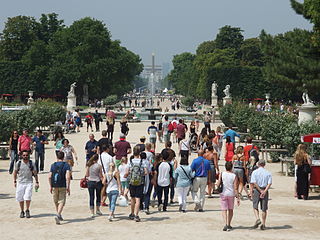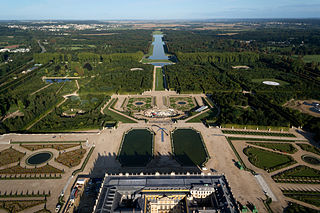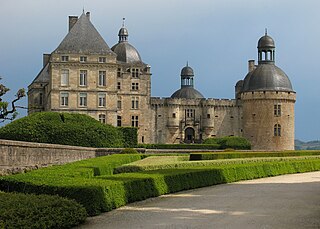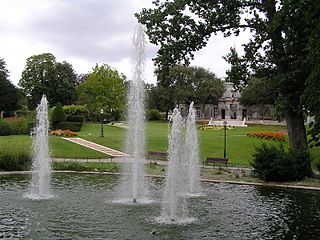
A garden is a planned space, usually outdoors, set aside for the cultivation, display, and enjoyment of plants and other forms of nature. The single feature identifying even the wildest wild garden is control. The garden can incorporate both natural and artificial materials.

The Tuileries Garden is a public garden between the Louvre and the Place de la Concorde in the 1st arrondissement of Paris, France. Created by Catherine de' Medici as the garden of the Tuileries Palace in 1564, it was opened to the public in 1667 and became a public park after the French Revolution. Since the 19th century, it has been a place for Parisians to celebrate, meet, stroll and relax.

The Jardin du Luxembourg, known in English as the Luxembourg Garden, colloquially referred to as the Jardin du Sénat, is located in the 6th arrondissement of Paris, France. The creation of the garden began in 1612 when Marie de' Medici, the widow of King Henry IV, constructed the Luxembourg Palace as her new residence. The garden today is owned by the French Senate, which meets in the Palace. It covers 23 hectares and is known for its lawns, tree-lined promenades, tennis courts, flowerbeds, model sailboats on its octagonal Grand Bassin, as well as picturesque Medici Fountain, built in 1620. The name Luxembourg comes from the Latin Mons Lucotitius, the name of the hill where the garden is located.

The Bois de Boulogne is a large public park that is the western half of the 16th arrondissement of Paris, near the suburb of Boulogne-Billancourt and Neuilly-sur-Seine. The land was ceded to the city of Paris by the Emperor Napoleon III to be turned into a public park in 1852.

The Villa Ephrussi de Rothschild, also called Villa Île-de-France, is a French seaside villa located at Saint-Jean-Cap-Ferrat on the French Riviera. Designed by the French architect Aaron Messiah, it was built between 1907 and 1912 by Baroness Béatrice de Rothschild (1864–1934).

Terrasson-Lavilledieu is a commune in the Dordogne department in Nouvelle-Aquitaine in southwestern France. The commune was created in 1963 by the merger of the former communes Terrasson and Lavilledieu. Terrasson station has rail connections to Bordeaux, Périgueux and Brive-la-Gaillarde.

The French formal garden, also called the jardin à la française, is a style of "landscape" garden based on symmetry and the principle of imposing order on nature. Its epitome is generally considered to be the Gardens of Versailles designed during the 17th century by the landscape architect André Le Nôtre for Louis XIV and widely copied by other European courts.

The Château de Hautefort is a French château and gardens located in the town of Hautefort in the Dordogne. The castle was originally a medieval fortress that was reconstructed in the 17th century, and embellished with a jardin à la française. In 1853 the landscape architect the Count of Choulot redesigned the gardens, adding a landscape garden, geometric flower gardens, topiary gardens imitating the domes of the château, and a long tunnel of greenery. Next to the formal gardens is a hill with an Italian garden with winding shaded paths. Notable trees in the park include a Magnolia grandiflora and a Cedar of Lebanon. The gardens are listed by the Committee of Parks and Gardens of the Ministry of Culture of France as one of the Notable Gardens of France.

The Palais Longchamp is a monument in the 4th arrondissement of Marseille, France. It houses the Musée des beaux-arts and Muséum d'histoire naturelle de Marseille. The surrounding Longchamp Park is listed by the French Ministry of Culture as one of the Notable Gardens of France.
The Jardin des Paradis is a private garden located on the Place du Théron, Cordes-sur-Ciel, Tarn, Midi-Pyrénées, France. It has been recognized as a Jardin Remarquable since 2004, and is open daily in the warmer months; an admission fee is charged.

The Château du Touvet is a French castle built in the 13th century, with a garden à la française and a water garden built in the 18th century, located between Grenoble and Chambéry in the Isère Department of the Rhône-Alpes Region of France. The gardens are classified among the notable gardens of France by the French Ministry of Culture. The chateau and gardens are privately owned, but open to the public.

A traditional Spanish garden is a style of garden or designed landscape developed in historic Spain. Especially in the USA, the term tends to be used of a garden design style with a formal arrangement that evokes, usually not very precisely, the sort of plan and planting developed in southern Spain, incorporating principles and elements from precedents in ancient Persian gardens, Roman gardens and Islamic gardens, and the great Moorish gardens of the Al-Andalus era on the Iberian Peninsula.

Cognac Public Garden is located in of the heart of the town of Cognac in the departement of Charente, France. It is one of the few English-styled gardens in France open to the general public. The park is the result of the marriage of the gardens of two adjoining properties; it houses the Hotel de Ville and the Museum of Art and History.

The Château de Saint-Just is a Renaissance castle with a park located in the Commune of Saint-Just near the town of Vernon in the Eure Department, in the region of upper Normandy, France. It was classified as an historic monument of France in 1995. The park is classified by the Committee of Parks and Gardens of the French Ministry of Culture as one of the Remarkable Gardens of France. The park is open to the public on certain hours from June first until August 1.

Paris today has more than 421 municipal parks and gardens, covering more than three thousand hectares and containing more than 250,000 trees. Two of Paris's oldest and most famous gardens are the Tuileries Garden, created in 1564 for the Tuileries Palace, and redone by André Le Nôtre in 1664; and the Luxembourg Garden, belonging to a château built for Marie de' Medici in 1612, which today houses the French Senate. The Jardin des Plantes was the first botanical garden in Paris, created in 1626 by Louis XIII's doctor Guy de La Brosse for the cultivation of medicinal plants. Between 1853 and 1870, the Emperor Napoleon III and the city's first director of parks and gardens, Jean-Charles Adolphe Alphand, created the Bois de Boulogne, the Bois de Vincennes, Parc Montsouris and the Parc des Buttes Chaumont, located at the four points of the compass around the city, as well as many smaller parks, squares and gardens in the neighborhoods of the city. One hundred sixty-six new parks have been created since 1977, most notably the Parc de la Villette (1987–1991) and Parc André Citroën (1992).

Parc Georges-Brassens is a public park located in the 15th arrondissement of Paris, between rue des Morillons and rue de Périchaux. Opened in 1984, it occupies 7.74 hectares on the site of a former fish market, horse market and slaughterhouse, and preserves some of the old market structures. It is named for the French popular singer Georges Brassens (1921–1981) who lived in the neighborhood of the park at 9 impasse Florimont and 42 rue Santos Dumont. The nearest metro stations to the park are Convention and Porte-de-Vanves.

The Parc de la Butte-du-Chapeau-Rouge formerly known as the Square de la Butte-du-Chapeau-Rouge, is a public park in the 19th arrondissement of Paris, which was created in 1939. It is an example of 1930s modernist park design, and contains a fountain and works of sculpture from the Exposition Internationale des Arts et Techniques dans la Vie Moderne (1937) held at the Trocadéro.

The Parc floral de Paris is a public park and botanical garden located within the Bois de Vincennes in the 12th arrondissement of Paris. Created in 1969, the park remains the legacy of the international horticultural exposition, which was organised under the auspices of the International Association of Horticultural Producers (AIPH) and recognised by the Bureau International des Expositions (BIE). It is one of four botanical gardens in Paris, and is the site of major annual flower shows. The nearest metro station to the park is Chateau-de-Vincennes.

The Jardins de Métis, also known in English as the Reford Gardens, is an English-style garden located at Grand-Métis, Quebec. Originally private, the gardens were opened to the public in 1962. The gardens were designated a Canadian National Historic Site in 1995 and as a Quebec heritage site by the Ministry of Culture and Communications of Quebec in 2013.


















